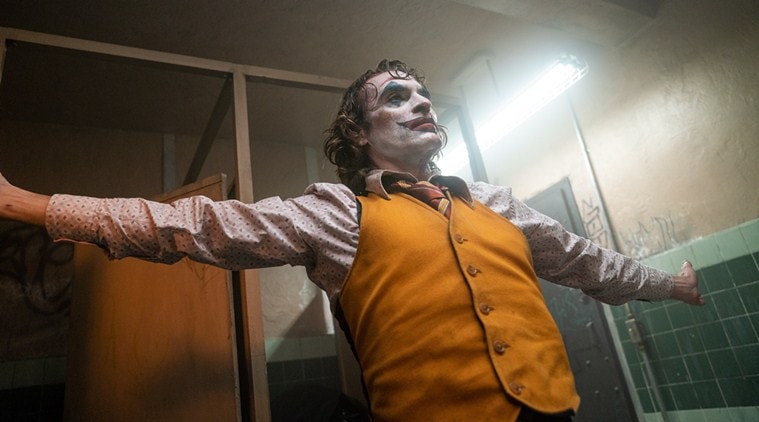Joaquin Phoenix is the embodiment of nervous, anorexic energy in his role. He just doesn’t act with his face — with or without the joker paint. He acts with his entire body, with its ribs sticking out, its back abnormally arched, its legs leaning away from him, its feet gliding from under him, its arms flailing about.
Joker movie cast: Joaquin Phoenix, Robert De Niro, Zazie Beetz, Frances Conroy
Joker movie director: Todd Phillips
Joker movie rating: 2.5 stars
How do you top one of the greatest villains of all time, one that even the Academy could not ignore? It certainly isn’t this Joker, despite Joaquin Phoenix putting all his acting’s might and, clearly, quite a bit of his weight’s worth, into it. Where Heath Ledger’s Joker was pure evil, that dripped from every crack of his peeling make-up, every snarl of his distorted grin, and every dart of his pink tongue, Phoenix’s Joker is a garden-variety villain born out of Hollywood’s usual spawn of abuse and society’s callousness.
That comedians are some of the world’s saddest people is now an accepted and easy truism. And there is almost nothing sunny about the life of Arthur Fleck (Phoenix). He works in a run-down laughter club, where people aren’t so nice to him; he gets beaten up routinely, the worst kind of thrashing; he lives in a building with mold growing on walls; and he comes back every night to an ailing mother (Conroy) who looks forward to him cooking, carrying and bathing her (sound familiar?). About the only cheery thing in his day is the nightly chat show he and his mother watch, where stand-up comic Murray Franklin (De Niro) cracks jokes and hosts star guests. Arthur, who carries around a battered journal where he scribbles morbid thoughts and poor jokes in equal measure, sees himself as another Murray Franklin.
That this is a fool’s dream is obvious from the start, including to his mother, with the film not giving Arthur even one real funny joke. This could have been a story about the costly price of the death of dreams. It isn’t.
That Arthur is a man of frail mental health, who leaves even his co-workers uneasy, who has spent time in a facility, who visits a counsellor, and who is on seven different medications, is obvious. That his mother chooses to ignore all this is too. This could have been a story about descent into madness. It isn’t.
That Arthur leans towards the rare people he sees as sympathetic towards him (mostly Black, or otherwise marginalised), including a pretty young mother (Beetz) in his building, is rubbed in. This could have been a story about two mothers, two relationships, and what is wished-for and what is real. It isn’t.
That there is a connection between Arthur and Thomas Wayne of Wayne Enterprises is among the film’s most interesting suggestions — tying the destinies of the Joker and Batman inescapably. You would think the film would make the most of it. it doesn’t.
Todd Phillips, writer plus co-writer with Scott Silver, who is most known for The Hangover films, tries all of the above, hoping something will stick. Apart from Phoenix, there is a lot else going for Phillips — the anticipation courtesy the Ledger legacy, Martin Scorsese briefly as producer, and the avowed inspiration drawn from Scorsese’s brand of protagonists who live on the edge. Only, the film seems to confuse living on the edge as being edgy.
Phoenix is the embodiment of nervous, anorexic energy in his role. He just doesn’t act with his face — with or without the joker paint. He acts with his entire body, with its ribs sticking out, its back abnormally arched, its legs leaning away from him, its feet gliding from under him, its arms flailing about. There is nothing linear about him, unlike the film which, as much as it tries to mould itself to his uniqueness, ends up being completely so.
It’s like an extended joke without a punchline. Worse, the joke may be on it. In The Dark Knight, Ledger’s Joker explains that it takes little to upend the world as we know it — all one has to do is “introduce a little anarchy”, upset the system’s “plans”. Joker 2019, based in Gotham City of a not-so-distant past, with a garbage strike bringing the “rats” out of sewers (no, there isn’t an embedded joke there either), dabbles with politics too — in which the clowns are the have-nots, rebelling against the haves of the system, and hence cheering on Arthur’s violent misdeeds.
The Dark Knight would balk at such facile black and whites; its Joker knew that what matters are the greys, where he revelled and where he dragged down the Batman. Plus, isn’t it the wrong time to draw a clown analogy? I thought these days we had one in the White House.
Source: Read Full Article


